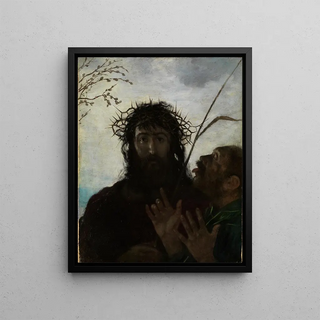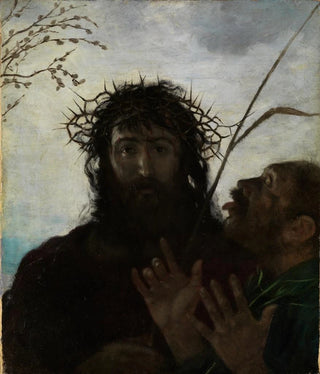Art print | The Derision of Jesus - Hans Thoma Source: Reproduction | La dérision de Jésus - Hans Thoma


View from behind

Frame (optional)
In the rich and complex landscape of religious art, "The Derision of Jesus" by Hans Thoma stands out for its emotional depth and unique treatment of the subject. This artwork, which evokes the suffering and mockery endured by Christ, invites viewers to an introspective reflection on the nature of faith and the human condition. Through a carefully crafted composition, Thoma manages to capture a moment of dramatic tension, where pain and dignity meet. The scene, imbued with an atmosphere that is both dark and luminous, serves as a true testament to the spiritual struggle that drives man in the face of adversity.
Style and uniqueness of the work
Hans Thoma's style, although rooted in the symbolist movement, is characterized by a personal approach that transcends the conventions of his time. In "The Derision of Jesus," the artist uses rich colors and striking contrasts to emphasize the intensity of emotions. The figures, though stylized, are poignantly expressive, each face telling a story, each gesture revealing an intention. Thoma skillfully plays with light, creating shadowed areas that enhance the drama of the scene. This artwork does not merely depict a biblical event; it invites broader contemplation on suffering and redemption, echoing the personal struggles of each individual.
The artist and his influence
Hans Thoma, an emblematic figure of 19th-century German art, knew how to mark his era with a work rich in symbolism and spirituality. Influenced by the great masters of painting, he nevertheless forged a style that is uniquely his own, blending tradition and innovation. Thoma was a passionate advocate for popular and rural art, seeking to depict everyday life and the beliefs of his time. His commitment to spiritual and moral themes made him a respected artist, whose influence endures to this day. "The Derision of Jesus" reflects this quest for meaning, revealing the depth of his reflection on faith and human suffering.
An exceptional wall decoration signed by Artem Legrand
In the context of interior decoration,

Matte finish

View from behind

Frame (optional)
In the rich and complex landscape of religious art, "The Derision of Jesus" by Hans Thoma stands out for its emotional depth and unique treatment of the subject. This artwork, which evokes the suffering and mockery endured by Christ, invites viewers to an introspective reflection on the nature of faith and the human condition. Through a carefully crafted composition, Thoma manages to capture a moment of dramatic tension, where pain and dignity meet. The scene, imbued with an atmosphere that is both dark and luminous, serves as a true testament to the spiritual struggle that drives man in the face of adversity.
Style and uniqueness of the work
Hans Thoma's style, although rooted in the symbolist movement, is characterized by a personal approach that transcends the conventions of his time. In "The Derision of Jesus," the artist uses rich colors and striking contrasts to emphasize the intensity of emotions. The figures, though stylized, are poignantly expressive, each face telling a story, each gesture revealing an intention. Thoma skillfully plays with light, creating shadowed areas that enhance the drama of the scene. This artwork does not merely depict a biblical event; it invites broader contemplation on suffering and redemption, echoing the personal struggles of each individual.
The artist and his influence
Hans Thoma, an emblematic figure of 19th-century German art, knew how to mark his era with a work rich in symbolism and spirituality. Influenced by the great masters of painting, he nevertheless forged a style that is uniquely his own, blending tradition and innovation. Thoma was a passionate advocate for popular and rural art, seeking to depict everyday life and the beliefs of his time. His commitment to spiritual and moral themes made him a respected artist, whose influence endures to this day. "The Derision of Jesus" reflects this quest for meaning, revealing the depth of his reflection on faith and human suffering.
An exceptional wall decoration signed by Artem Legrand
In the context of interior decoration,






